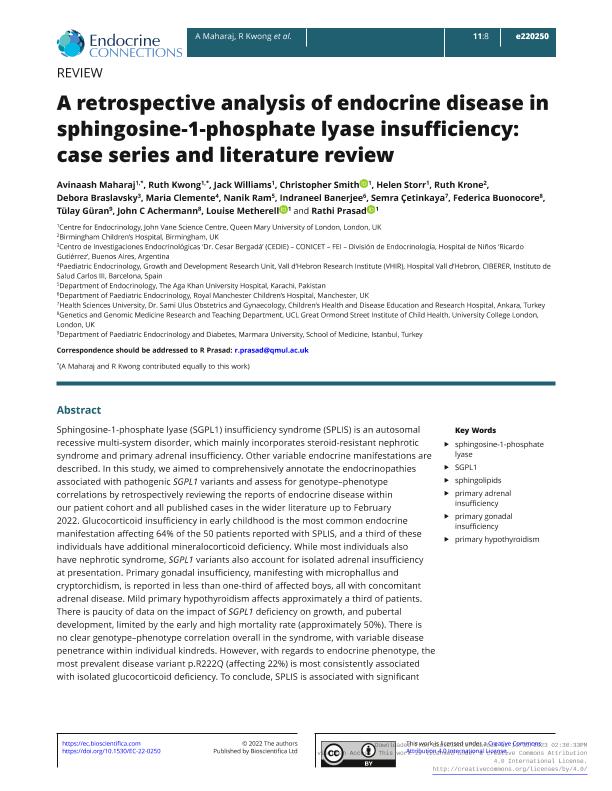Artículo
A retrospective analysis of endocrine disease in sphingosine-1-phosphate lyase insufficiency: case series and literature review
Maharaj, Avinaash; Kwong, Ruth; Williams, Jack; Smith, Christopher; Storr, Helen; Krone, Ruth; Braslavsky, Debora Giselle ; Clemente, Maria; Ram, Nanik; Banerjee, Indraneel; Çetinkaya, Semra; Buonocore, Federica; Güran, Tülay; Achermann, John C.; Metherell, Louise; Prasad, Rathi
; Clemente, Maria; Ram, Nanik; Banerjee, Indraneel; Çetinkaya, Semra; Buonocore, Federica; Güran, Tülay; Achermann, John C.; Metherell, Louise; Prasad, Rathi
 ; Clemente, Maria; Ram, Nanik; Banerjee, Indraneel; Çetinkaya, Semra; Buonocore, Federica; Güran, Tülay; Achermann, John C.; Metherell, Louise; Prasad, Rathi
; Clemente, Maria; Ram, Nanik; Banerjee, Indraneel; Çetinkaya, Semra; Buonocore, Federica; Güran, Tülay; Achermann, John C.; Metherell, Louise; Prasad, Rathi
Fecha de publicación:
07/2022
Editorial:
BioScientifica
Revista:
Endocrine Connections
e-ISSN:
2049-3614
Idioma:
Inglés
Tipo de recurso:
Artículo publicado
Clasificación temática:
Resumen
Sphingosine-1-phosphate lyase (SGPL1) insufficiency syndrome (SPLIS) is an autosomal recessive multi-system disorder, which mainly incorporates steroid-resistant nephrotic syndrome and primary adrenal insufficiency. Other variable endocrine manifestations are described. In this study, we aimed to comprehensively annotate the endocrinopathies associated with pathogenic SGPL1 variants and assess for genotype–phenotype correlations by retrospectively reviewing the reports of endocrine disease within our patient cohort and all published cases in the wider literature up to February 2022. Glucocorticoid insufficiency in early childhood is the most common endocrine manifestation affecting 64% of the 50 patients reported with SPLIS, and a third of these individuals have additional mineralocorticoid deficiency. While most individuals also have nephrotic syndrome, SGPL1 variants also account for isolated adrenal insufficiency at presentation. Primary gonadal insufficiency, manifesting with microphallus and cryptorchidism, is reported in less than one-third of affected boys, all with concomitant adrenal disease. Mild primary hypothyroidism affects approximately a third of patients. There is paucity of data on the impact of SGPL1 deficiency on growth, and pubertal development, limited by the early and high mortality rate (approximately 50%). There is no clear genotype–phenotype correlation overall in the syndrome, with variable disease penetrance within individual kindreds. However, with regards to endocrine phenotype, the most prevalent disease variant p.R222Q (affecting 22%) is most consistently associated with isolated glucocorticoid deficiency. To conclude, SPLIS is associated with significant multiple endocrine disorders. While endocrinopathy in the syndrome generally presents in infancy, late-onset disease also occurs. Screening for these is therefore warranted both at diagnosis and through follow-up.
Archivos asociados
Licencia
Identificadores
Colecciones
Articulos(CEDIE)
Articulos de CENTRO DE INVESTIGACIONES ENDOCRINOLOGICAS "DR. CESAR BERGADA"
Articulos de CENTRO DE INVESTIGACIONES ENDOCRINOLOGICAS "DR. CESAR BERGADA"
Citación
Maharaj, Avinaash; Kwong, Ruth; Williams, Jack; Smith, Christopher; Storr, Helen; et al.; A retrospective analysis of endocrine disease in sphingosine-1-phosphate lyase insufficiency: case series and literature review; BioScientifica; Endocrine Connections; 11; 8; 7-2022; 1-13
Compartir
Altmétricas



